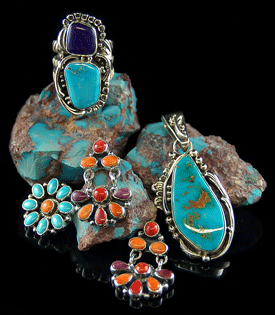
As a side note: Turquoise is mined in Arizona, New Mexico, Colorado, Nevada, and California…all over the southwestern US except Utah, which is known for our copper mine! That’s okay, though, we have Variscite – and we’ll talk about that a little later. This occurs in arid regions like the American Southwest and the Middle East. In other words water, which has been heated under the earth, rises upward through limonite rock and creates turquoise in the cracks and crevasses of weathered rock. Turquoise forms as a secondary mineral by percolation through acidic aqueous solutions where the primary rock is volcanic with high levels of limonite, iron oxide and copper. It has a perfect cleavage and conchoidal fracture with crystals being rare to form in the stone. Turquoise mines in the Southwest United States are the most famous, such as Bisbee, Lander Blue, Number Eight or Lone Mountain. Only certain regions on earth provide this recipe for turquoise to form. Turquoise is a very soft stone ranging from 0 – 6 on the Mohs’ scale with most of the stones falling in the 5-6 range, or about as hard as the glass in your windows. 'Turquoise is found at elevations between 3,000 and 8,500 feet (914 and 2,590 meters) and typically in dry, arid climates. Natural Turquoise (not High Grade, but standard jewelry.

Turquoise FactsĬhemically Turquoise is made of Copper, Aluminum and trace amounts of Iron in what is called a “hydrous phosphate” its chemical formula is Cu(Al,Fe3+)6(PO4)4(OH)8 x4H2O. These top three Turquoise Grades are usually in the 5-7 range on the Mohs Scale of gemstone hardness.

Marcia Kertel created this Kokopeilli necklace from sterling silver and both raw and tumbled Turquoise from New Mexico. Turquoise that is greener in color has a higher concentration of iron. The color of the stone comes from copper, and varies depending on the concentration of copper in the chemical formula. Today the United States has become the largest producer of gem-quality turquoise with the finest specimens being from Arizona, and Nevada. The turquoise from these mines rivaled any found in Persia and exceeded the quality in many cases. In ancient times, the best mines producing the finest colors of turquoise were found in Persia, but in the late 1800s, miners re-discovered Aztec mines in Arizona and the Western United States. The most prized color of Turquoise in antiquity, and now, is the intense blue most commonly associated with Turquoise as a color, but is very hard to find naturally in a stone. It would be approximately 1,200 to1,500 carats in size. A pound of this stone would cost approximately 60,000, roughly three times what gold costs today. Although Turquoise is the word we’ve used for several centuries, Pliny the Elder called it Callais, the miners in Iran searched for Priouzeh, and the Aztecs carved their power statues of Moctezuma from Teoxihuitl. In 2014, turquoise of this quality, known as the gem grade, could sell for between 40 and 95 per carat, or 007 ounces. The word Turquoise is an Old French word meaning “Turkish” which is where the Europeans first found the gem mined from the Khorasan Province in Iran for sale in the bazaars of Turkey. So Emilie finished polishing it all the way around, and wrapped both pieces in sterling silver wire! Called Moon over the Horizon, the moon face is made from carved yak bone. Emilie Jefferson belongs to a lapidary club, and as she was polishing this turquoise stone she cut, it broke.


 0 kommentar(er)
0 kommentar(er)
